Apple Refreshes iPad Pro Lineup: A10X Fusion SoC for 10.5-inch, 12.9-inch Models
by Matt Humrick on June 6, 2017 6:00 PM EST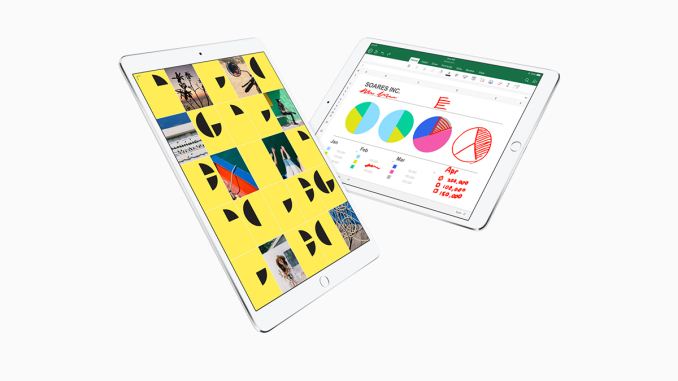
In addition to showing off its latest OS and software updates, Apple made several hardware announcements at WWDC 2017, including a refreshed iPad Pro lineup. The smaller of the two Pros ditches the 9.7-inch screen, which dates all the way back to the original iPad, for a 10.5-inch panel that fits into a chassis only 10.6mm (0.42”) taller and 4.6mm (0.18”) wider than the outgoing model thanks to smaller bezels. The expanded all-aluminum chassis increases weight by 7% or 32 grams, just enough to notice if you’re familiar with one of the recent models. The larger 12.9-inch Pro—first released at the end of 2015—finally gets some attention too. After missing out on the new hardware introduced with the 9.7-inch iPad Pro last year, the big Pro has been brought up to parity with the new 10.5-inch Pro.
Both the 10.5-inch and 12.9-inch LCD panels are new for this generation and share the same specifications. The 264ppi panels can display more vivid and lifelike colors by extending color coverage well beyond the sRGB standard with DCI-P3 gamut support. And because iOS supports ColorSync, Apple’s color management system, the Pros’ wide-gamut panels maintain color accuracy by respecting the source material’s target gamut (no overly-vivid, neon colors when viewing sRGB content, for example).
Both models also support Apple’s True Tone display technology that adjusts the display’s white point based on ambient light. The idea here is for the screen to replicate what happens to a white sheet of paper under different lighting conditions. If you read a printed book in an incandescent bulb’s warm light, the page will reflect that light and appear warmer, more yellow. True Tone does the same thing, reducing the LCD’s blue output and shifting the white point to appear warmer. Matching the display’s output to its environment is supposed to reduce eye strain, but True Tone can be disabled if it’s not to your liking.
Apple claims both displays can hit 600 nits peak brightness, which is impressive for tablets. We previously measured the 9.7-inch iPad Pro at 520 nits and the 12.9-inch iPad Pro at 427 nits, so this should bring a noticeable visibility improvement in bright light, especially for the big Pro. Both panels are also fully laminated to the cover glass and use an improved antireflective coating to further improve visibility and diminish eye strain by reducing screen reflections. The improved coating was first used on the 9.7-inch iPad Pro, and after comparing it side by side with the iPad Air 2, I was really impressed with how well it works.
| Apple iPad Pro Comparison | ||||
| iPad Pro 10.5" (2017) |
iPad Pro 12.9" (2017) |
iPad Pro 9.7" (2016) |
iPad Pro 12.9" (2015) |
|
| SoC | Apple A10X Fusion 3x Apple performance cores 3x Apple efficiency cores 12 core GPU |
Apple A9X 2x Apple Twister @ ~2.2GHz PowerVR 12 Cluster Series7XT |
||
| Display | 10.5-inch 2224x1668 IPS LCD DCI-P3, 120Hz |
12.9-inch 2732x2048 IPS LCD DCI-P3, 120Hz |
9.7-inch 2048x1536 IPS LCD DCI-P3 |
12.9-inch 2732x2048 IPS LCD sRGB |
| Dimensions | 250.6 x 174.1 x 6.1 mm 469 / 477 grams (WiFi / LTE) |
305.7 x 220.6 x 6.9 mm 677 / 692 grams (WiFi / LTE) |
240.0 x 169.5 x 6.1 mm 437 / 444 grams (WiFi / LTE) |
305.7 x 220.6 x 6.9 mm 713 / 723 grams (WiFi / LTE) |
| RAM | ? | 4GB LPDDR4 | 2GB LPDDR4 | 4GB LPDDR4 |
| NAND | All: 64GB / 256GB / 512 GB | All: 32GB / 128GB / 256GB |
WiFi: 32GB / 128GB / 256GB WiFi + Cellular: 128GB / 256GB |
|
| Battery | 30.4 Wh | 41.0 Wh | 27.5 Wh | 38.5 Wh |
| Front Camera | 7MP, f/2.2, Auto HDR, Wide Color Gamut, Retina Flash | 5MP, f/2.2 | 1.2MP, f/2.2 | |
| Rear Camera | 12MP, 1.22µm pixels, f/1.8, PDAF, OIS, Auto HDR, Wide Color Gamut, True Tone Quad-LED flash | 12MP, 1.22µm pixels, f/2.2, True Tone LED flash | 8MP, 1.1µm pixels, f/2.4 | |
| Cellular | 2G / 3G / 4G LTE (Category 9) | 2G / 3G / 4G LTE (Category 4) | ||
| SIM Size | NanoSIM | NanoSIM | ||
| Wireless | 802.11a/b/g/n/ac 2x2 MIMO, BT 4.2 LE, GPS/GLONASS | 802.11a/b/g/n/ac 2x2 MIMO, BT 4.2 LE, GPS/GLONASS | ||
| Connectivity | Apple Lightning, 3.5mm headphone, Apple Smart Connector | Apple Lightning, 3.5mm headphone, Apple Smart Connector | ||
| Launch OS | iOS 10 | iOS 9 | ||
| Launch Price | Wi-Fi: $649 (64GB) $749 (256GB) $949 (512GB) Wi-Fi + LTE: $779 (64GB) $879 (256GB) $1079 (512GB) |
Wi-Fi: $799 (64GB) $899 (256GB) $1099 (512GB) Wi-Fi + LTE: $929 (64GB) $1029 (256GB) $1229 (512GB) |
Wi-Fi: $599 (32GB) $749 (128GB) $899 (256GB) |
Wi-Fi: $799 (32GB) $949 (128GB) $1079 (256GB LTE) |
Before we move on to other hardware, it’s worth mentioning that Apple is using an adaptive refresh rate on the new Pros, a technology it calls ProMotion. The standard refresh rate doubles from 60Hz to 120Hz, which should help UI animations appear more fluid. It also reduces the Apple Pencil’s latency, making inking smoother with less lag. Driving a panel at 120Hz increases power consumption (panel and SoC), however. To help reduce the impact on battery life, the refresh rate is adjusted down to 24Hz or 48Hz when displaying content that would not benefit from the faster refresh, such as reading an ebook or Web page, for example.
Under the display is an Apple A10X Fusion SoC that comes with additional CPU and GPU cores compared to the A10 Fusion SoC used in the iPhone 7. Instead of 2 performance CPU cores and 2 efficiency cores, the A10X Fusion uses 3 of each. It also doubles the number of GPU cores, which makes sense considering it needs to drive a lot more pixels at a higher refresh rate. Apple claims a 30% improvement in CPU performance and a 40% faster GPU compared to the Apple A9X SoC used in the previous generation.
It’s still not clear how much RAM the new Pros have. It’s probably safe to assume that the 12.9-inch model still comes with 4GB, but does the 10.5-inch model stick with 2GB like the 9.7-inch Pro? Considering all of the new multitasking features and visual elements in iOS 10/11, a bump to 4GB is certainly justified, although, Apple tends to be frugal with RAM.
Internal storage capacity doubles, with the least-expensive models packing 64GB of NAND. The next two storage tiers jump to 256GB and 512GB, which makes these iPads a bit more competitive with other ultraportable devices targeted at professionals. The extra space is also essential if you plan to use an iPad for less ‘Pro’ purposes such as watching TV shows or movies, which eat up space quickly.
The cameras on iPads have always seemed like an afterthought, with Apple using iPhone leftovers a generation or two old. Because tablets typically are not the first device people reach for when shooting photos and video, camera hardware is an obvious place to save money. This is not the case with the new iPad Pros, however, which receive the biggest camera upgrade since Apple first added cameras to the iPad 2. Both the front and rear camera modules are shared with the iPhone 7. That means a 7MP FaceTime HD camera on the front that supports automatic HDR imaging, wide color gamut photos, and 1080p video recording. You can also use the iPad’s display as a flash. Around back is a 12MP camera with 1.22µm pixels, OIS, Focus Pixels (PDAF), a 6-element lens array with a large f/1.8 aperture, and a quad-LED True Tone flash. It also supports automatic HDR imaging and wide color gamut photos and uses OIS and EIS for stabilizing video.
The new Pros come with 802.11ac 2x2 MIMO Wi-Fi that offers a peak theoretical throughput of 866Mbps. Like previous iPads, there’s Wi-Fi only and Wi-Fi + LTE cellular variants. The cellular-enabled models get a new Category 9 LTE modem with up to 450Mbps on the downlink. There’s also support for 25 LTE bands and an embedded Apple SIM.
The new iPad Pros look like, well…iPads. The aluminum shell is visually indistinguishable from earlier models and still has a Lightning connector on the bottom, a 3.5mm headphone jack and power button in opposite corners at the top, volume buttons on one side, and an Apple Smart Connector on the other. The proprietary Smart Connector transfers both data and power to optional peripherals such as external keyboards. There are also 4 speakers—2 on the top and 2 on the bottom—that provide better sound than the mono speakers on older iPads and are less prone to being covered by your hands when holding it in landscape mode.
The 12.9-inch Pro looks the same as the previous version from the front, while the 10.5-inch Pro has noticeably narrower bezels along the sides of the display. The physical home button includes an upgraded Touch ID sensor (same as iPhone 7) that’s 2x faster.
Both the 10.5-inch and 12.9-inch iPad Pros are available for preorder and will begin shipping mid June. Unlike the iPhone 7, Apple is not offering any new color choices for the iPads, so we get the familiar Silver, Space Gray, Gold, and Rose Gold. The Apple Pencil can be purchased separately for $99, and Apple offers its Smart Keyboard for $159 and $169 for 10.5- and 12.9-inch models, respectively.


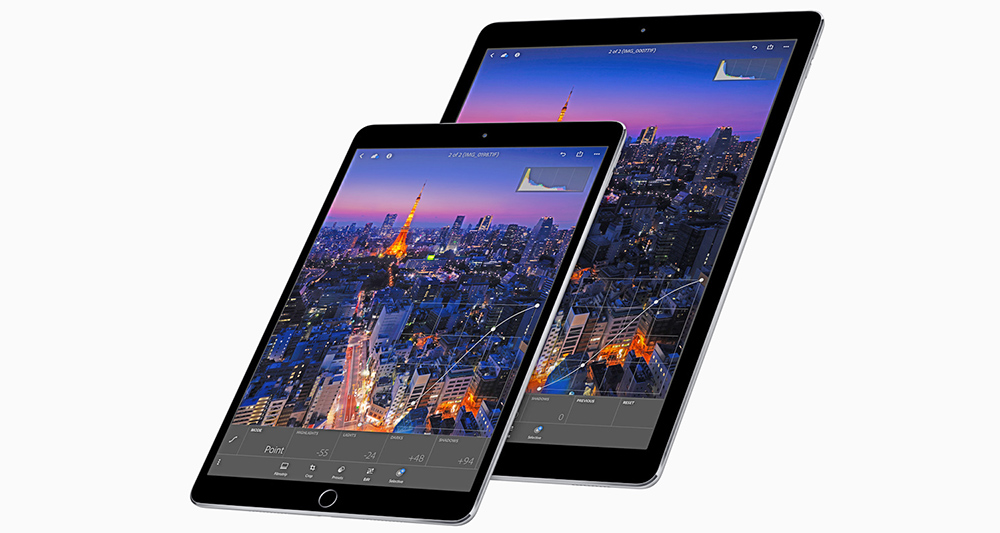
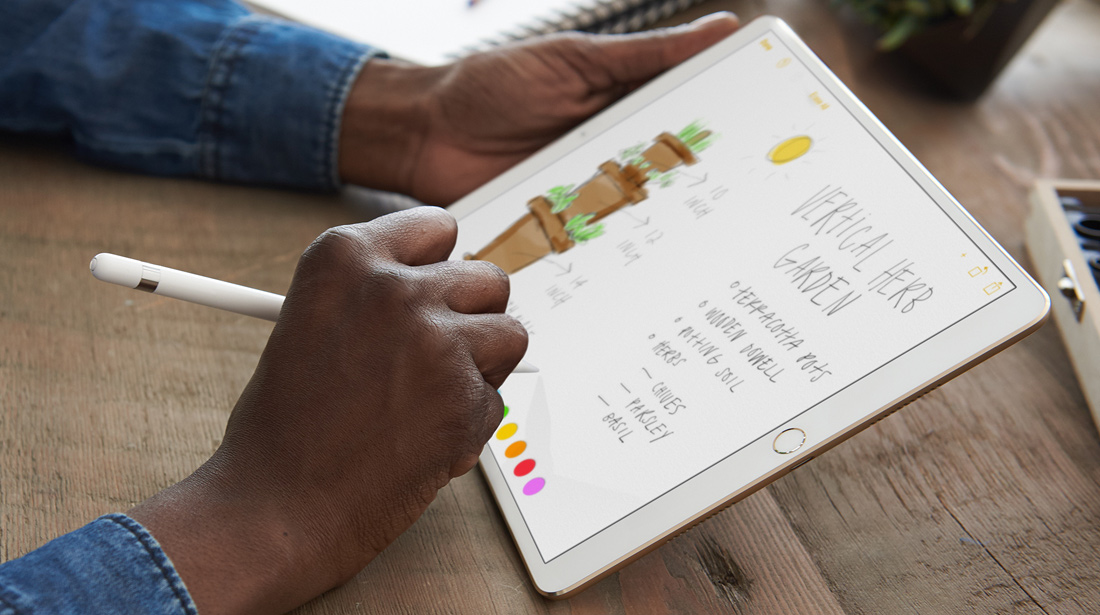
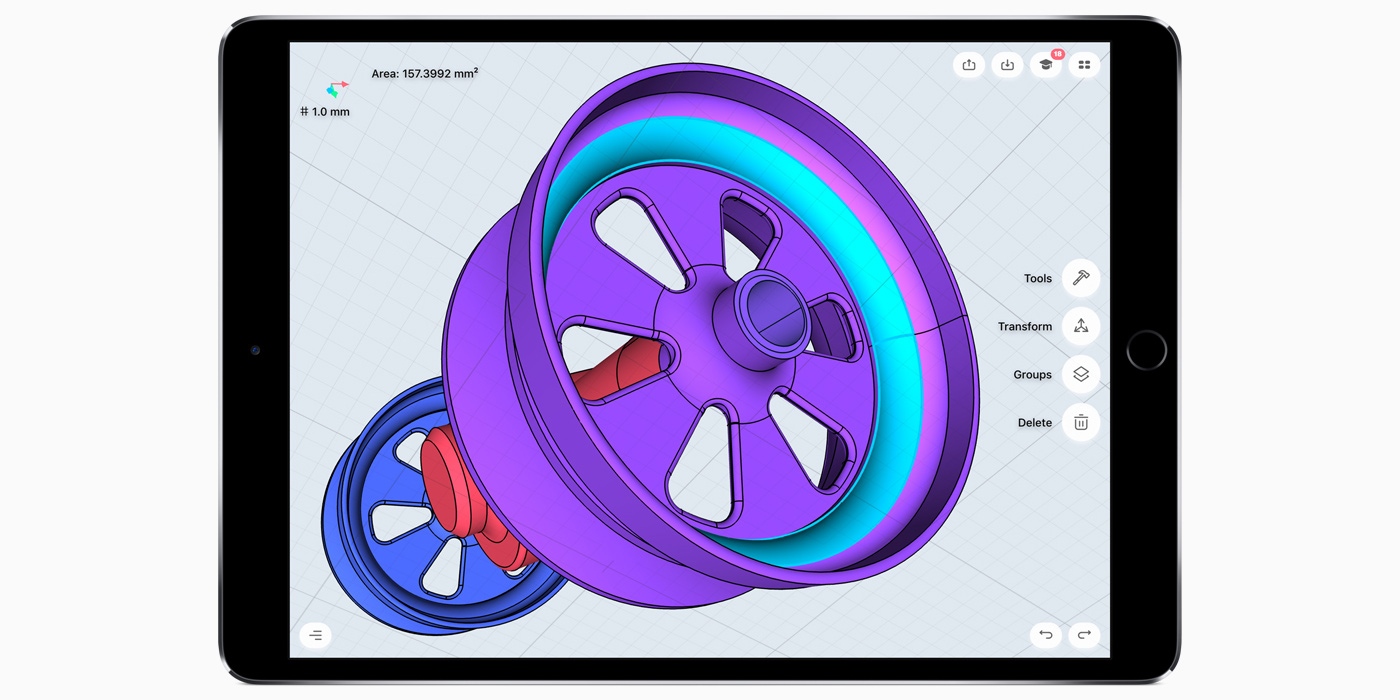
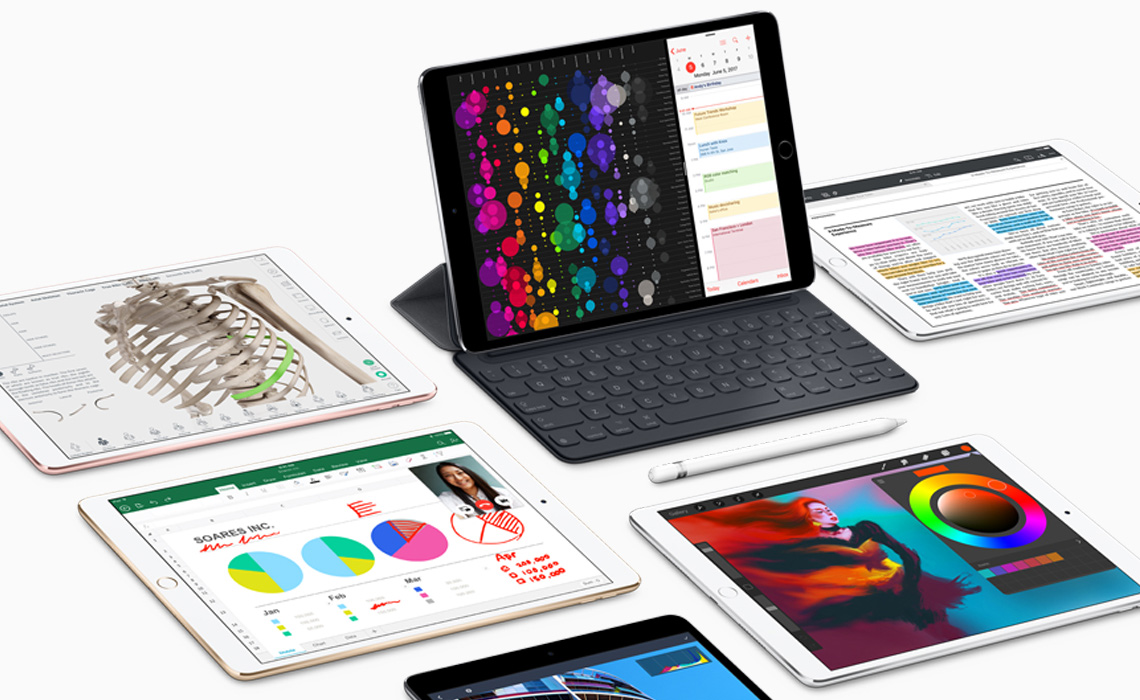








108 Comments
View All Comments
melgross - Wednesday, June 7, 2017 - link
The more cores there are, the weaker they are. There's just only so much room on the chip. It's why Apple's cores have been about twice as powerful as the same gen designs from other vendors.I imagine, this time round, Apple found benefits from three cores - or, as with the A8X, when they also had three cores, going to a new process hindered them from doing bigger cores, and next gen they'll go back to 2 cores again.
name99 - Wednesday, June 7, 2017 - link
I don't think it's likely that space forced the switching between 2 and 3 cores; my guess is it's more a process of learning and exploration.Remember that
(a) these SoCs are designed some years in advance of when they ship, and who knows how late in the process the number of cores has to be decided
(b) the cores are basically tiny compared to the die as a whole. The entire CPU complex takes up like 15% of the die, compared to ~50% for the GPU.
It probably seemed plausible in the past that two cores was appropriate for iPad software, but that that calculation has changed as iOS has grown up, now allowing two apps (plus PiP) to have UI simultaneously, with three apps (plus PiP) in iOS 11. My guess is that three cores for iPad is the new standard going forward, not an aberration. (The A8X was, I suspect, a compromise resulting from some disagreement --- some saying "let's try it and see, and we'll learn a few things about going beyond a dual-core system", some saying "it's a waste of area"; with the A9X the argument for learning was no longer valid; but by A10X the value of the extra cores, given the direction of iPad software, had proven itself.)
We can compare with desktops where the most recent study a few years ago suggested that for most purposes the appropriate number of cores was three (up from two about ten years before that...) Intel dual-core with hyper-threading kinda matches that, hence that's what we see as the standard issue CPU in most consumer computers.
melgross - Wednesday, June 7, 2017 - link
The reason given as to why Apple went to 3 cores for the A8x was because of a new process where Apple didn't want to go to a new, more complex architecture, and didn't want to bulk the cores up too much, so they went to 3 cores instead. I imagine the same is true here.A choice was to have 2 more complex, and bigger cores, or three refined cores that were about the same size as last year's (where they went back to 2 cores), using up the space of the smaller process. 3 bigger, more powerful cores wouldn't fit.
Whether these cores take up 15% doesn't matter, everything on the chip has it's place, and space. If they were to go to 3 more powerful cores, they could have needed 20%, or more, and they didn't have it.
Meteor2 - Wednesday, June 7, 2017 - link
Space is not an issue, but power (or rather the resulting heat) is. These devices have a fixed power budget. Designers can spend it across 1 core or 4 or whatever.Personally I don't think there's significance in the core count.
melgross - Thursday, June 8, 2017 - link
It depends. Apple's 2 core chips have always (since the A6) been well ahead for single core performance, but multicore performance has been behind. With the A8x and now this, it's ahead in both areas.When I'm talking about area, I'm talking about whether Apple went with 2 even bigger cores vs three somewhat smaller cores, which they seem to have done, vs 3 larger cores. What we don't know, since some testing on the new iPad has come out, is the efficiency tradeoff. We're seeing a 30% increase in single core, as Apple stated, but a whopping 80% increase in multicore. That's significant.
This is probably 10nm, despite what some here think, though I could be wrong. So Apple had to decide where they went. Often they increase efficiency, as they did last year, along with increased performance. It will be interesting to see where they went with this.
sonicmerlin - Sunday, June 11, 2017 - link
The 3 cores mimics the iPad Air 2 SoC, which they probably realized is beneficial when running multiple apps simultaneously as iOS 11 allows. I doubt you would need 4 cores for anything.damianrobertjones - Wednesday, June 7, 2017 - link
You might need to see if there are any mites outside!GC2:CS - Wednesday, June 7, 2017 - link
Well yeah after 18 months I expected more.But might be because they are still stuck on 16nm like A9X, where the third core was omited for a better GPU. I think if A10X is 10nm they would invest more into more GPU cores too considering the big density gains.
Now 16nm got better yelds, better perf more cores.
And is that 30% a total increase or a single core one ? Because I don't think they would go back in IPC now with huricane.
If it's a 30 percent more single core plus aditional core, the CPU upgrade actually seems much more impressive than the GPU one...
But still is that 40% more from original 12,9 Pro or 9,7" ? Both have identical performance or its been again scalled for different resolutions ?
What about power consumption ? Both having bigger batteries is a plus.
Conclusion is that we need 10nm for a bigger jump, we see a nice compariom between super early finfet (A9X) and a late one (A10X). And I think all 10nm at TSMC is consumed by new iPhones getting a big boost in perf possibly even bigger than iPad Pro.
asendra - Wednesday, June 7, 2017 - link
30% single core. 80% more multi core.http://browser.geekbench.com/v4/cpu/compare/303638...
psychobriggsy - Wednesday, June 7, 2017 - link
Well that's pretty beastly really. 5% higher clockspeed, so IPC goes up significantly again. Probably the same core in the next iPhone, but in a 2+2 configuration. Likely 10nm.